Difference between revisions of "Heuchera rubescens"
in H. Stansbury, Exped. Great Salt Lake, 388, plate 5. 1852,.
imported>Volume Importer |
imported>Volume Importer |
||
| Line 1: | Line 1: | ||
{{Treatment/ID | {{Treatment/ID | ||
|accepted_name=Heuchera rubescens | |accepted_name=Heuchera rubescens | ||
| − | |accepted_authority=Torrey | + | |accepted_authority=Torrey |
|publications={{Treatment/Publication | |publications={{Treatment/Publication | ||
|title=in H. Stansbury, Exped. Great Salt Lake, | |title=in H. Stansbury, Exped. Great Salt Lake, | ||
| Line 86: | Line 86: | ||
-->{{#Taxon: | -->{{#Taxon: | ||
name=Heuchera rubescens | name=Heuchera rubescens | ||
| − | |authority=Torrey | + | |authority=Torrey |
|rank=species | |rank=species | ||
|parent rank=genus | |parent rank=genus | ||
| Line 100: | Line 100: | ||
|publication year= | |publication year= | ||
|special status=Illustrated | |special status=Illustrated | ||
| − | |source xml=https:// | + | |source xml=https://bitbucket.org/aafc-mbb/fna-data-curation/src/2e0870ddd59836b60bcf96646a41e87ea5a5943a/coarse_grained_fna_xml/V8/V8_190.xml |
|genus=Heuchera | |genus=Heuchera | ||
|species=Heuchera rubescens | |species=Heuchera rubescens | ||
Latest revision as of 22:42, 5 November 2020
Herbs acaulescent or subcaulescent; caudex branched. Flowering stems (6–)10–32(–50) cm, short stipitate-glandular. Leaves: petiole glabrous or short to long stipitate-glandular; blade suborbiculate or broadly ovate, shallowly 3–7-lobed, 0.6–4.5 cm, base cordate or truncate, lobes rounded, margins dentate, apex acute or acuminate, surfaces glabrous or long stipitate-glandular on veins abaxially, glabrous or short stipitate-glandular adaxially. Inflorescences dense, diffuse in fruit, (often secund). Flowers: hypanthium slightly bilaterally symmetric, free 0.5–2 mm, longer on adaxial side, pink to rose, narrowly campanulate with obconic base, becoming urceolate, 3–6.5 mm, short stipitate-glandular proximally, long stipitate-glandular distally; sepals erect, often green- or red-tipped, equal or unequal (longer on abaxial side of hypanthium), 1–3.3 mm, apex obtuse or rounded; petals spreading, pink, linear or narrowly oblanceolate, (clawed, ± equal), unlobed, 2–3(–6) mm (equaling or longer than sepals, rarely shorter), margins entire; stamens exserted 0.8–3 mm; styles exserted 0.5–2 mm, 1.5–2.5 mm, to 0.1 mm diam. Capsules urceolate, 3–6 mm; beaks divergent, papillose or not. Seeds dark brown, fusiform, 0.5–0.9 mm. 2n = 14, 28.
Phenology: Flowering Apr–Sep.
Habitat: Cracks and ledges in shaded rocky cliffs and outcrops
Elevation: 900-3700 m
Distribution

Ariz., Calif., Colo., Idaho, Nev., N.Mex., Oreg., Tex., Utah, Mexico (Baja California).
Discussion
Heuchera rubescens occurs throughout most of the Intermountain Region except the Uinta Mountains and basin in Utah.
This complex has always been extremely difficult taxonomically. Almost every minor variant in such characters as the level of insertion of stamens in relation to petals, the shape and length of hypanthium and petals, the size, hairiness, and shape of leaf blades, and the length of petioles has been given a name and recognized at various taxonomic ranks, often without correlation to any pattern of geographical distribution. We agree with P. K. Holmgren and N. H. Holmgren (1997) that, pending a thorough phylogenetic study, it seems best to recognize a single polymorphic species without infraspecific taxa.
The Gosiute Indians used a decoction of roots of Heuchera rubescens as an astringent on the skin and gave it to babies with colic. The Paiute used an infusion of roots as an eyewash and took a decoction of roots for venereal disease. The Shoshoni took an infusion of the roots for diarrhea and liver trouble or biliousness; they used a decoction of the roots for high fever, heart trouble, venereal disease, and general debility. They also used mashed, boiled leaves as a wash for horses’ saddle sores and gave soaked roots to horses and cows for cramps (D. E. Moerman 1998).
Selected References
None.
